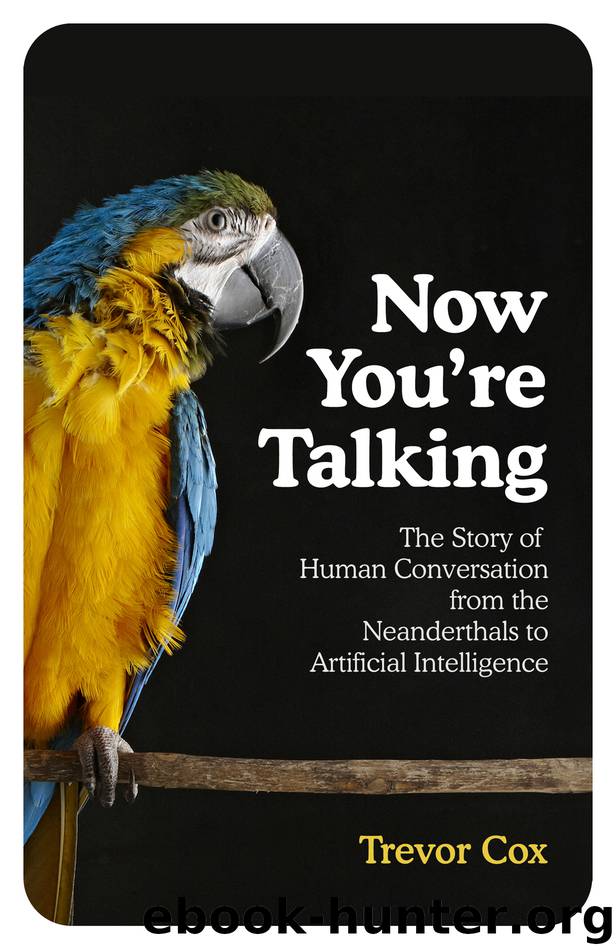Now You're Talking by Trevor Cox

Author:Trevor Cox
Language: eng
Format: epub
Publisher: Random House
All the Robots Merely Players
EDISON’S EARLY DEMONSTRATIONS of recorded voices created great excitement but at times the scraping of the needle on the tinfoil drowned out the speech. The playback was distorted, with the New York Times describing ‘queer, piping tones peculiar to the phonograph and the puppets of a Punch and Judy show’.1 The electrical engineer Sir William Henry Preece believed that it was a bad idea to use the device for those with the purest voices, like opera star Adelina Patti or a great orator such as Gladstone.2 For Preece the reproduced sound was ‘to some extent … a burlesque or parody of the human voice’.3 Today a computer-generated voice taking on a role from a Shakespeare play would probably elicit a similar description. Feeding the script into a modern speech synthesiser might produce intelligible words, but the awkward intonation would create a caricature of a human actor.
At this point you might well be imagining Stephen Hawking playing Hamlet, but in fact, Hawking uses pretty outdated technology. Understandably, he refuses to ‘upgrade’ his voice because it has become central to his identity. State-of-the-art speech synthesisers are much more natural, however, with voices like Siri, the iPhone assistant, becoming part of everyday life for many people. When I embarked on this chapter, the speech-synthesis community was getting excited about the latest technology to emerge from DeepMind, the company that made headlines when its artificial intelligence software AlphaGo sensationally beat a professional Go player in 2016. Researchers were scrambling to try and replicate the impressive synthesised speech that DeepMind had produced.
As we edge ever nearer to the point where robot speech may be indistinguishable from a human talking, should those of us who use their voice professionally be worried? Will the time come soon when I present my last documentary for BBC radio? After all, the corporation has just begun to translate and voice-over some news bulletins in Russian and Japanese using artificial voices.4 This is being done to offer more foreign-language services and so is not putting human newsreaders out of business – well, not yet …
What about actors, the ultimate voice professionals? Some theatre companies have already experimented with robot actors. There’s no need for Luddite action, however, because the machines are not replacing human actors but are playing themselves. My Square Lady, for example, is an opera where a robot called Myon is cast in an analogous role to Eliza Doolittle from the musical My Fair Lady. Whereas Eliza had elocution lessons to change her social status, Myon is taught how to feel and express emotions and thereby become more human. As AI gets better and computer speech improves, will a staging of Shakespeare’s As You Like It include the modified lines, ‘All the world’s a stage, and all the robots merely players’?
Machines that speak have theatrical roots. The first true speech synthesiser was a mechanical device created by the Hungarian Wolfgang von Kempelen at the end of the eighteenth century. Kempelen was a true polymath: a politician, artist and inventor, and notably also a showman.
Download
This site does not store any files on its server. We only index and link to content provided by other sites. Please contact the content providers to delete copyright contents if any and email us, we'll remove relevant links or contents immediately.
| Anthropology | Archaeology |
| Philosophy | Politics & Government |
| Social Sciences | Sociology |
| Women's Studies |
Cecilia; Or, Memoirs of an Heiress — Volume 1 by Fanny Burney(32436)
Cecilia; Or, Memoirs of an Heiress — Volume 2 by Fanny Burney(31871)
Cecilia; Or, Memoirs of an Heiress — Volume 3 by Fanny Burney(31856)
The Great Music City by Andrea Baker(31367)
We're Going to Need More Wine by Gabrielle Union(18969)
All the Missing Girls by Megan Miranda(15579)
Pimp by Iceberg Slim(14396)
Bombshells: Glamour Girls of a Lifetime by Sullivan Steve(13976)
Talking to Strangers by Malcolm Gladwell(13223)
Norse Mythology by Gaiman Neil(13209)
Fifty Shades Freed by E L James(13157)
For the Love of Europe by Rick Steves(13032)
Mindhunter: Inside the FBI's Elite Serial Crime Unit by John E. Douglas & Mark Olshaker(9205)
Crazy Rich Asians by Kevin Kwan(9169)
The Lost Art of Listening by Michael P. Nichols(7409)
Enlightenment Now: The Case for Reason, Science, Humanism, and Progress by Steven Pinker(7237)
The Four Agreements by Don Miguel Ruiz(6635)
Bad Blood by John Carreyrou(6552)
Weapons of Math Destruction by Cathy O'Neil(6147)
